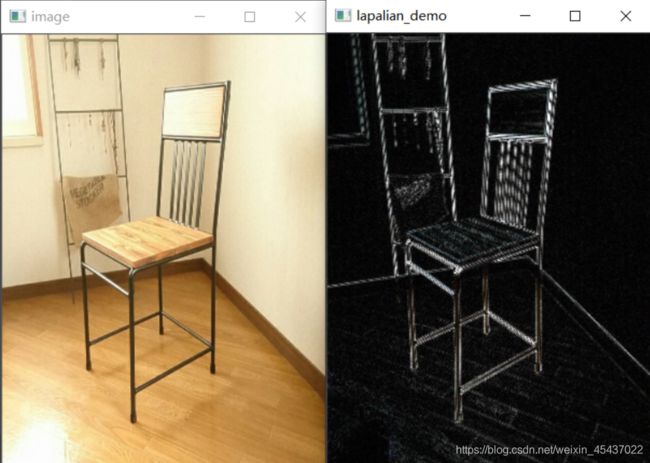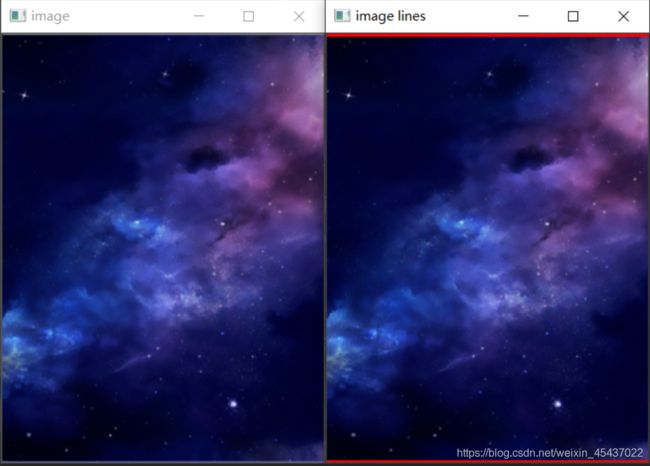【Python】OpenCV库学习笔记(七)
OpenCV库学习笔记(七)
- 1. 图像梯度
-
- 1.1 Soble算子
- 1.2 拉普拉斯算子
- 2. Canny边缘提取
-
- 2.1 Canny算法介绍
- 2.2 代码演示
- 3. 直线检测
-
- 3.1 霍夫直线变换介绍
- 3.2 代码演示
1. 图像梯度
1.1 Soble算子
- 求x,y方向图像梯度
import cv2 as cv
def sobel_demo(image):
grad_x = cv.Sobel(image, cv.CV_32F, 1, 0) # 求x方向的梯度,对x求一阶导数
grad_y = cv.Sobel(image, cv.CV_32F, 0, 1) # 求x方向的梯度,对y求一阶导数
gradx = cv.convertScaleAbs(grad_x)
grady = cv.convertScaleAbs(grad_y)
cv.imshow("grandient-x", gradx)
cv.imshow("grandient-y", grady)
image = cv.resize(cv.imread("01.jpg"), (300,400))
cv.imshow("image", image)
sobel_demo(image)
cv.waitKey(0)
cv.destroyAllWindows()
- 求整体梯度
import cv2 as cv
def sobel_demo(image):
grad_x = cv.Sobel(image, cv.CV_32F, 1, 0)
grad_y = cv.Sobel(image, cv.CV_32F, 0, 1)
gradx = cv.convertScaleAbs(grad_x)
grady = cv.convertScaleAbs(grad_y)
gradxy = cv.addWeighted(gradx, 0.5, grady, 0.5, 0)
cv.imshow("gradxy",gradxy)
image = cv.resize(cv.imread("01.jpg"), (300,400))
cv.imshow("image", image)
sobel_demo(image)
cv.waitKey(0)
cv.destroyAllWindows()
1.2 拉普拉斯算子
- 拉普拉斯算子
import cv2 as cv
def lapalian_demo(image):
dst = cv.Laplacian(image, cv.CV_32F)
lpls = cv.convertScaleAbs(dst)
cv.imshow("lapalian_demo", lpls)
image = cv.resize(cv.imread("01.jpg"), (300,400))
cv.imshow("image", image)
lapalian_demo(image)
cv.waitKey(0)
cv.destroyAllWindows()
- 自定义拉普拉斯算子
import cv2 as cv
import numpy
def lapalian_demo(image):
kernel = numpy.array([[0, 1, 0], [1, -4, 1], [0, 1, 0]])
lpls = cv.filter2D(image, cv.CV_32F, kernel=kernel)
cv.imshow("lapalian_demo", lpls)
image = cv.resize(cv.imread("01.jpg"), (300,400))
cv.imshow("image", image)
lapalian_demo(image)
cv.waitKey(0)
cv.destroyAllWindows()
2. Canny边缘提取
2.1 Canny算法介绍
Canny是边缘检测算法,是1986年提出的
步骤:对彩色图像进行高斯模糊,去除噪声,再进行灰度转换,对图像求取梯度,根据图像角度实现非最大信号压制,进行高低阈值过滤
- 高斯模糊:GaussianBlur
- 灰度转换:cvtColor
- 计算梯度:Sobel/Scharr
- 非最大信号抑制
- 高低阈值输出二值图像
2.2 代码演示
import cv2 as cv
import numpy
def edge_demo(image):
blurred = cv.GaussianBlur(image, (3, 3), 0)
gray = cv.cvtColor(blurred, cv.COLOR_BGR2GRAY)
# x gradient
gradx = cv.Sobel(gray, cv.CV_16SC1, 1, 0)
grady = cv.Sobel(gray, cv.CV_16SC1, 0, 1)
# edge 高阈值为150 低阈值为50
edge_output = cv.Canny(gradx, grady, 50, 150)
cv.imshow("Canny Edge", edge_output)
dst = cv.bitwise_and(image, image, mask=edge_output)
cv.imshow("Color Edge", dst)
image = cv.resize(cv.imread("01.jpg"), (300,400))
cv.imshow("image", image)
edge_demo(image)
cv.waitKey(0)
cv.destroyAllWindows()
3. 直线检测
3.1 霍夫直线变换介绍
- Hough Line Transform用来做直线检测
- 前提条件:边缘检测已经完成
- 需要理解:平面空间到极坐标空间转换
3.2 代码演示
import cv2 as cv
import numpy
def line_detection(image):
gray = cv.cvtColor(image, cv.COLOR_BGR2GRAY)
edges = cv.Canny(gray, 50, 150, apertureSize=3)
lines = cv.HoughLines(edges, 1, numpy.pi/180, 200)
for line in lines:
rho, theta = line[0]
a = numpy.cos(theta)
b = numpy.sin(theta)
x0 = a * rho
y0 = b * rho
x1 = int(x0 + 1000 * (-b))
y1 = int(y0 + 1000 * (a))
x2 = int(x0 - 1000 * (-b))
y2 = int(y0 - 1000 * (a))
cv.line(image, (x1, y1), (x2, y2), (0, 0, 255), 2)
cv.imshow("image lines", image)
image = cv.resize(cv.imread("star.jpg"), (300,400))
cv.imshow("image", image)
line_detection(image)
cv.waitKey(0)
cv.destroyAllWindows()



